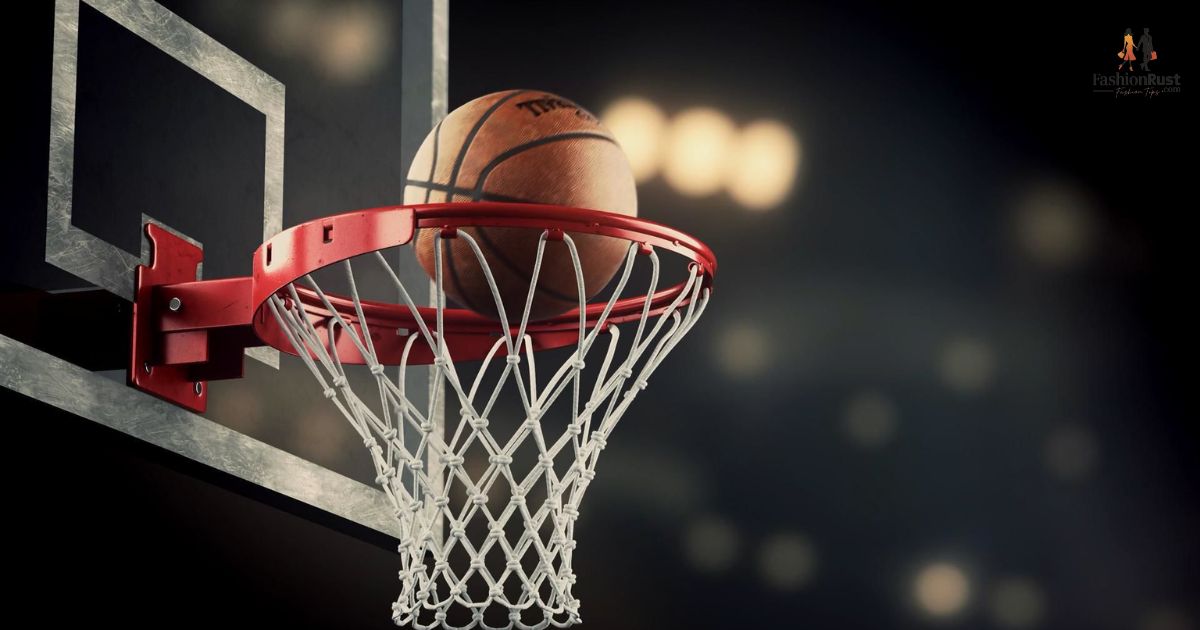Basketball hoops are an iconic symbol of the sport, but have you ever wondered about their exact height? This guide delves into the standard measurements for basketball rims across various leagues and competitions, from professional to recreational levels.
People know that basketball hoops are “high up,” the specific regulations might surprise you. We’ll explore the uniform 10-foot standard used in the NBA, NCAA, and high school games, as well as the slight variation in Olympic competitions.
Beyond just rim height, this comprehensive look at basketball equipment covers backboard dimensions, net specifications, and the factors that influence these standards.
Key Takeaways

The standard height for basketball hoops across most professional and collegiate leagues is 10 feet (3.05 metres). This height, originally established by the sport’s inventor James Naismith, has remained consistent in the NBA, WNBA, NCAA, and high school competitions. It provides a uniform challenge for players and ensures consistency across different courts and arenas.
While professional leagues maintain the 10-foot standard, youth and recreational leagues often use adjustable hoops. These can be set lower, typically between 8 to 10 feet, to accommodate younger players or those still developing their skills. This flexibility allows for more inclusive play and helps in skill development.
Backboard sizes and net specifications are also regulated in professional leagues to ensure fairness and consistency. These can vary in recreational settings, allowing for personalization and creativity in home or community courts.
Some are,
- The official height for professional basketball hoops is 10 feet (3.05 metres)
- Olympic basketball uses a slightly higher rim at 10 feet 2 inches (3.05 metres)
- Adjustable hoops in youth leagues typically range from 8 to 10 feet in height
Basketball Hoop Height Regulations By League and Competition Level
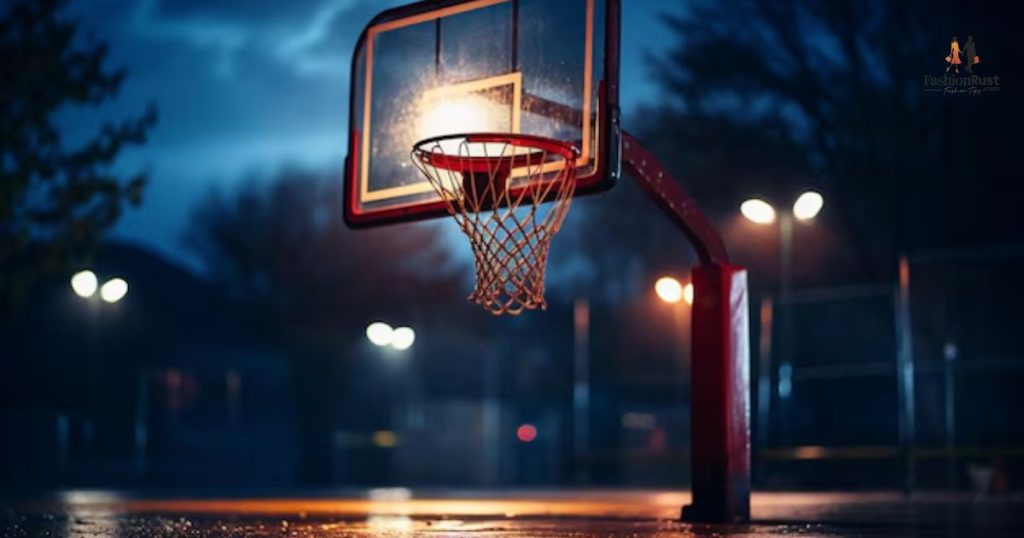
Basketball hoop height regulations vary across different leagues and competition levels, though there is a remarkable consistency at the higher levels of play. Most professional and collegiate leagues adhere to the standard 10-foot rim height, ensuring a uniform playing experience for athletes across various venues.
While the 10-foot standard prevails in adult competitions, youth leagues often employ adjustable hoops to accommodate younger players. These adaptable systems allow for heights ranging from 8 to 10 feet, facilitating skill development and ensuring that the game remains accessible and enjoyable for players of all ages and abilities.
The Official NBA Basketball Hoop Height
The National Basketball Association (NBA) mandates a uniform hoop height of 10 feet (3.05 metres) for all official games. This standard has remained unchanged since the league’s inception and is consistent across all 30 NBA arenas, ensuring a level playing field for all teams and players.
The 10-foot height presents a significant challenge even for professional athletes, requiring a combination of skill, timing, and exceptional vertical leap to score. This standard height contributes to the excitement of NBA games, making dunks and blocked shots impressive feats of athleticism.
In addition to the rim height, the NBA also regulates other aspects of the hoop, including an 18-inch diameter for the rim and a standard backboard size of 72 inches by 42 inches. These specifications, combined with the 10-foot height, create the iconic basketball setup that fans worldwide recognize as the pinnacle of the sport.
NCAA College Basketball Hoop Height
Like the NBA, NCAA college basketball adheres to the standard 10-foot rim height. This consistency ensures that college players are prepared for professional play and maintains uniformity across all levels of competitive basketball.
These standardised measurements apply to all NCAA divisions and tournaments, including the highly popular March Madness. By maintaining these specifications, the NCAA ensures fair competition
High School Basketball Hoop Height
High school basketball courts also feature the regulation 10-foot rim height, aligning with college and professional standards. This consistency is crucial for young athletes developing their skills and aspiring to play at higher levels.
Despite the typically smaller stature of high school players compared to college or professional athletes, maintaining the standard 10-foot height presents an appropriate challenge. It encourages players to improve their jumping ability, shooting accuracy, and overall athleticism.
The uniformity of hoop height across high school gymnasiums also promotes fair competition in interscholastic games and tournaments. Whether playing at home or away, teams can expect consistent court conditions, allowing them to focus on strategy and skill rather than adjusting to varying hoop heights.
Read Related Article…
Is Mbappe Gay? The Truth About The Kylian Mbappé Relationship
WNBA Basketball Hoop Height
The Women’s National Basketball Association (WNBA) adheres to the same standard hoop height as the NBA. Contrary to some misconceptions, WNBA courts feature rims set at 10 feet (3.05 metres) from the floor to the top of the rim.
This consistency in hoop height across professional leagues emphasises that basketball is a game of skill, strategy, and athleticism regardless of gender. WNBA players demonstrate exceptional talent and precision while competing at the same rim height as their male counterparts.
Olympic Basketball Hoop Height
Olympic basketball presents a slight deviation from the standard hoop height used in most professional leagues. In Olympic competitions, the rim is set at 10 feet 2 inches (3.05 metres) from the playing surface to the rim’s midpoint.
This small increase in height adds an extra challenge for even the world’s top athletes. It requires players to make subtle adjustments to their shooting and dunking techniques, potentially impacting gameplay at the highest international level.
The Olympic standard, governed by FIBA (International Basketball Federation) rules, creates a unique playing environment. It distinguishes Olympic basketball from other global competitions and adds an extra layer of difficulty for players accustomed to the 10-foot standard used in their domestic leagues.
Youth and Recreational Basketball Adjustable Hoop Heights
Youth basketball leagues often use adjustable hoops to accommodate players of different ages and skill levels. This flexibility allows children to develop their skills progressively as they grow and improve.
The adjustability of these hoops serves multiple purposes. It enables younger or smaller players to experience success in shooting and develop proper form without being discouraged by an unreachable target.
Recreational basketball systems with variable rim heights cater to a wide range of players, from toddlers to teenagers. This versatility makes basketball accessible to all age groups and skill levels, promoting inclusivity and encouraging participation in the sport.
Hare are some,
- Adjustable heights range from as low as 2 feet for toddlers to the regulation 10 feet
- Common heights are tailored to specific age groups
- Flexibility allows for skill development and gradual progression
- Promotes inclusivity and participation across various age groups
The crucial factor is selecting hoop heights that align with players’ physical capabilities, including their reach and vertical leap. This tailored approach ensures full participation, fostering an enjoyable environment where players can effectively enhance their basketball skills.
| Age Group | Common Basketball Hoop Heights |
| Toddlers | 2-4 feet |
| Young Children | 4-8 feet |
| Older Youth Leagues | 8-10 feet |
These adjustable heights ensure that young players can enjoy the game and develop their skills at an appropriate level before transitioning to the standard 10-foot hoop used in competitive play.
Basketball Backboard Size Regulations
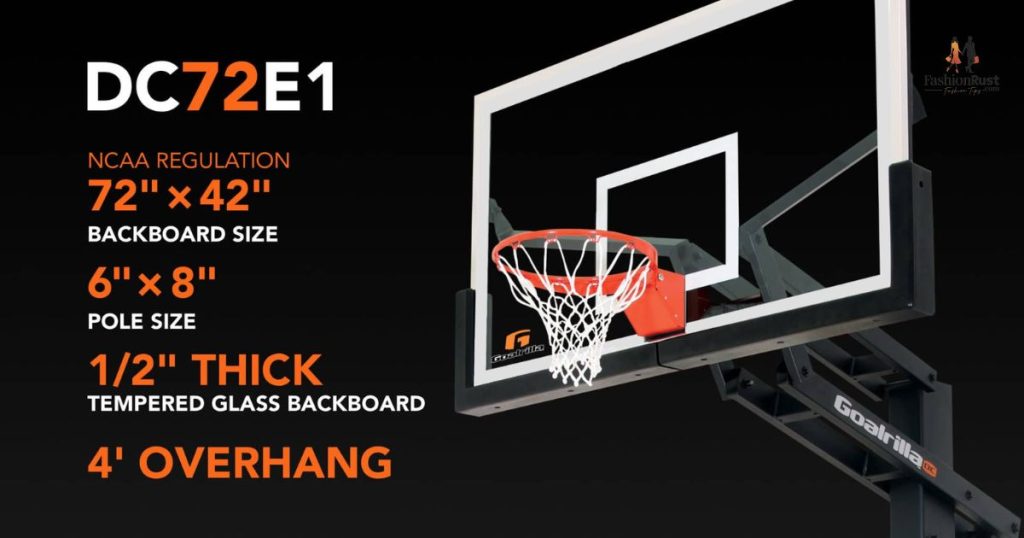
Basketball backboards are subject to specific size regulations that vary depending on the league and level of play. These standardised dimensions ensure consistency across different courts and competitions.
For professional leagues like the NBA and NCAA, as well as high school basketball, the standard backboard size is 72 inches wide by 42 inches tall (rectangular shape). International competitions governed by FIBA allow for some variation, with backboards measuring 59 inches wide by 45 inches tall, and the option for either rectangular or trapezoidal shapes.
These regulations are crucial for maintaining fairness and consistency in the game. They ensure that players can develop and apply their skills uniformly across different courts and competitions.
Some are,
- NBA, NCAA, and high school standard: 72″ x 42″ (rectangular)
- FIBA standard: 59″ x 45″ (rectangular or trapezoidal)
- Regulations ensure consistency across different courts
- Some flexibility may be allowed in recreational or lower-level play
Why Backboard Size Matters
Backboard size significantly impacts shooting techniques. Larger backboards provide more surface area for bank shots, allowing players to utilise a wider range of angles and strategies when shooting. This can affect shooting accuracy and success rates, particularly for players who rely on bank shots.
The size of the backboard also influences rebounding. Bigger backboards increase the likelihood of missed shots bouncing back into play rather than going out of bounds. This creates more rebounding opportunities, potentially leading to more second-chance points and affecting team strategies for both offensive and defensive rebounding.
Backboard dimensions contribute to the overall spectacle of the game. Larger backboards can facilitate more dramatic plays, such as emphatic blocks or powerful dunks that shake the entire goal structure. These elements enhance the visual appeal and excitement of the game for both players and spectators.
Factors That Influence Basketball Rim Height
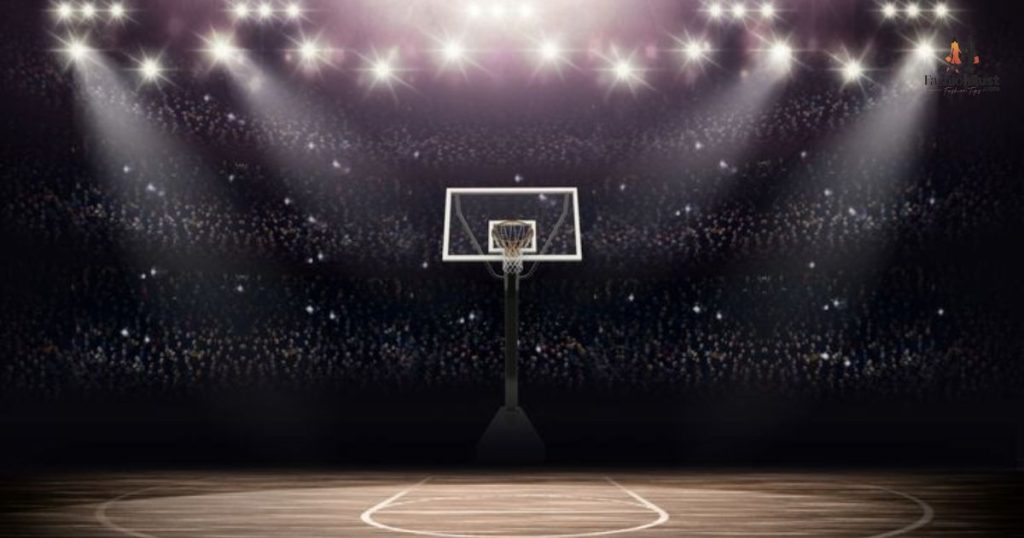
Several factors determine the optimal height for basketball rims. League standards play a crucial role, with most professional and collegiate leagues adhering to the 10-foot standard. However, factors such as player demographics, skill levels, and the purpose of play (competitive vs. recreational) can influence rim height in other settings.
The balance between challenge and accessibility is another key consideration. Rim height needs to be high enough to challenge players and maintain the integrity of the game, but not so high that it becomes prohibitively difficult for the average player. This balance is particularly important in youth and recreational leagues.
Conforming to Relevant League Standards
Basketball rim heights are primarily determined by the standards set by governing bodies for different levels of play. Professional leagues like the NBA and WNBA, collegiate associations such as the NCAA, and international bodies like FIBA all have specific regulations for rim height. These standards ensure consistency across different courts .
Adhering to these standards is crucial for official games and tournaments. Teams and venues must comply with the regulations of their respective leagues or risk penalties. This standardisation not only ensures fair play but also allows for accurate record-keeping and comparison of performances across different games and seasons.
Average Player Heights and Vertical Reach
The average height and vertical reach of players in a given league or age group are important considerations in determining appropriate rim height. These factors help ensure that the game remains challenging yet accessible to the majority of players.
In professional leagues, where players tend to be taller and have exceptional vertical leaps, the standard 10-foot rim provides an appropriate challenge. In youth leagues or recreational settings, adjustable rims allow for customization based on the average physical capabilities of the players, ensuring.
Ease of Dunking Entertainment Value
The height of basketball rims significantly impacts the frequency and spectacle of dunking. Lower rims make dunking more accessible to a wider range of players, potentially increasing the excitement and entertainment value of the game.
However, excessively low rims can trivialise the skill required for dunking and diminish its impact. Professional leagues maintain the 10-foot standard to ensure that dunks remain an impressive display of athleticism and skill, contributing to the overall entertainment value of the sport.
Read Related Article…
Katy O’Brian Gender, Spouse, and Biography
Adjustable Hoops Allowing Versatility
Adjustable basketball hoops offer flexibility for players of different ages and skill levels. They allow for customization based on factors such as player height, age, and ability, making the game more inclusive and enjoyable for all participants.
Some are,
- Can be adapted for different age groups and skill levels
- Allow for progressive skill development
- Useful for practice drills and specialised training
- Enable multiple sports use of the same equipment
- Accommodate both recreational and competitive play
Measuring Basketball Rim Height Correctly
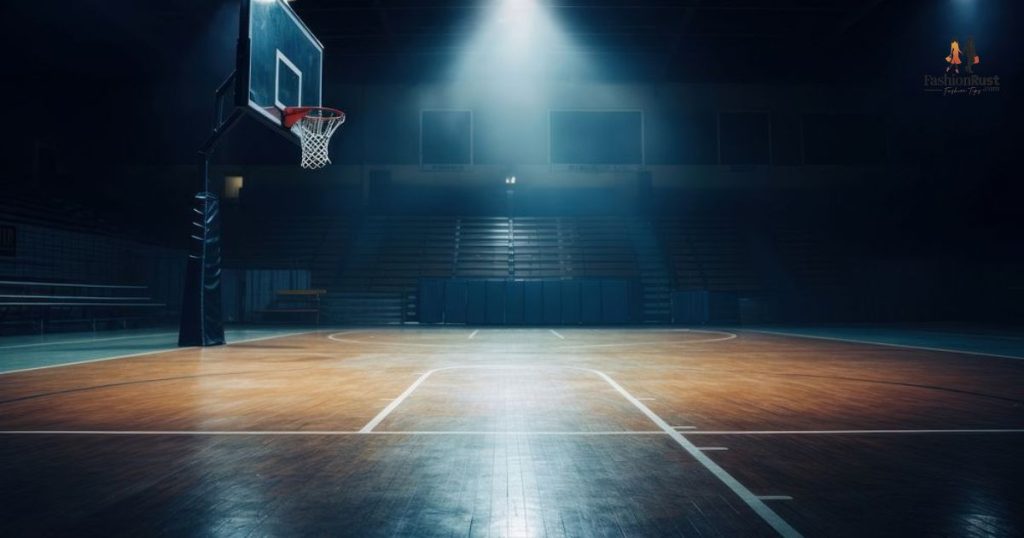
Accurate measurement of basketball rim height is crucial for ensuring compliance with regulations and maintaining fair play. The standard method involves measuring from the playing surface to the top of the rim using a reliable measuring tool, typically a steel tape measure.
Proper measurement techniques include using a stable ladder, ensuring the playing surface is level, and taking measurements from multiple points around the rim to account for any potential unevenness. It’s also important to verify that the backboard is at the correct height and angle relative to the court.
Use Proper Equipment
Accurately measuring basketball rim height requires the right tools. Essential equipment includes:
- Retractable Steel Tape Measure: Should extend to at least 12 feet for overhead reaching
- Step Ladder or Stepladder: Must be stable, anti-slip, and include safety railings
- 4 Ft & 6 Ft Bubble Levels: Extended lengths to span the rim underside
- Adjustable Wrench: For loosening pole joint collars if adjustments are needed
Using proper equipment ensures precise measurements and promotes safety during the process. The steel tape measure provides accuracy, while a sturdy ladder allows for secure access to the rim. Bubble levels help verify that the rim is perfectly horizontal, and an adjustable wrench enables fine-tuning of the hoop height if necessary.
Read Related Article…
Jelly Roll’s Wife Bunnie Xo: Birthday, Real Name, Age, Family, Net Worth
Rim to Backboard Basketball Hoop Measurement
An alternative method to measure basketball hoop height involves using the backboard as a reference point. This technique is particularly useful for systems where the rim’s underside lip is not easily visible.
Some ara,
- Position the ladder safely near the backboard
- Extend the tape measure from the top edge of the backboard to the rim perimeter
- Ensure the measurement is taken perpendicular to the backboard
- The distance should be 138-140 inches for regulation specifications
- Measure from both sides of the rim to cross-check accuracy
This method provides a reliable way to verify rim height, especially when direct floor-to-rim measurement is challenging.
Basketball Net Information
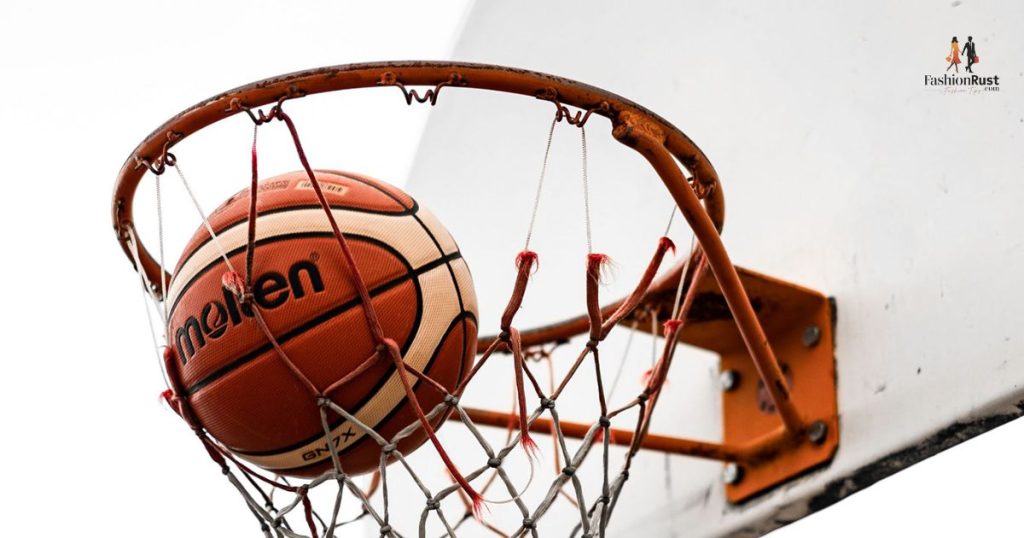
Basketball nets are a crucial component of the hoop assembly, completing the visual and auditory experience of the game. Regulation nets are typically made of nylon cords or weather-resistant chain mesh, with specific requirements for cord diameter, length, and number of connectors.
Regular inspection and replacement of nets are important for maintaining the quality of play and safety. Nets should be replaced when showing signs of wear such as missing hooks, torn loops, or excessive weathering. Creative options like glow-in-the-dark or LED-lit nets can add flair to recreational courts while still meeting regulation standards.
Net Specifications
Basketball nets must meet specific criteria to ensure proper function and durability. Key specifications include:
- Material: Typically nylon cords or premium weather-resistant chain mesh construction
- Cord Diameter: Maximum thickness of 15-18mm
- Length: Optimal length of 15-18 inches from rim collar bottom to net bottom
- Connectors: Stainless snap hooks, resistant to rust and tarnishing
- Number: 12-15 cords or links for durability and shape retention
These specifications ensure that the net performs consistently during play, providing the satisfying “swish” sound and visual confirmation of successful shots. The materials and design also contribute to the net’s longevity and ability to withstand various weather conditions, particularly for outdoor courts.
Replacing Old Basketball Nets
Regular inspection and timely replacement of basketball nets are crucial for maintaining optimal playing conditions. Signs that indicate a net needs replacement include missing hooks, torn connecting loops, loose or disconnected chords, warped shape, holes, abnormal wear patterns, and weathering damage.
Ideally, nets should be replaced every 12-24 months, depending on the intensity of use and exposure to weather elements. However, nets showing clear signs of defects or unsafe conditions should be replaced immediately to ensure player safety and preserve the quality of the game.
Creative and Fun Basketball Net Options
- Multi-color swish-tone nets: Add visual pop to shot arcs
- Glow-in-dark nets: Enhance nighttime driveway play
- Chain mesh nets: Offer higher durability and distinctive metallic swish
- Custom logo/text nets: Great for branding home courts
- LED lighted nets: Provide flashy lighting effects during play
- Collegiate team logo nets: Show school spirit
- No net option: Streetball style, or for soccer practice kicks
Frequently Asked Questions
How tall is an NBA basketball hoop?
10 feet (305 cm)
Do WNBA hoops have the same height as NBA hoops?
Yes, WNBA hoops are also 10 feet tall
What’s the standard backboard size for NBA and NCAA?
72 inches wide by 42 inches tall (rectangular)
How often should basketball nets be replaced
Every 12-24 months, or immediately if damaged
What’s a common basketball hoop height for young children?
4-8 feet
Are Olympic basketball hoops the same height as NBA hoops?
No, Olympic hoops are slightly higher at 10 feet 2 inches (3.05 metres)
Final Thoughts
Understanding basketball hoop dimensions and regulations is crucial for players, coaches, and facility managers across all levels of the game. From the standard 10-foot height in professional leagues to adjustable systems for youth development, proper hoop specifications ensure fair play and skill progression.
Regular maintenance, including accurate measurements and timely net replacements, is essential for preserving the integrity of the game. Whether on a professional court or in a backyard, adhering to these standards and guidelines helps maintain the spirit of basketball while promoting safety and enjoyment for all participants.

As a creative spirit with a passion for all things fashion, I thrive on imagining and bringing to life unique styles through my designs. With over 5 years spent cultivating my skills and collaborating with top names in the industry, I have developed a keen eye for aesthetics and unparalleled expertise in crafting looks that turn heads.
